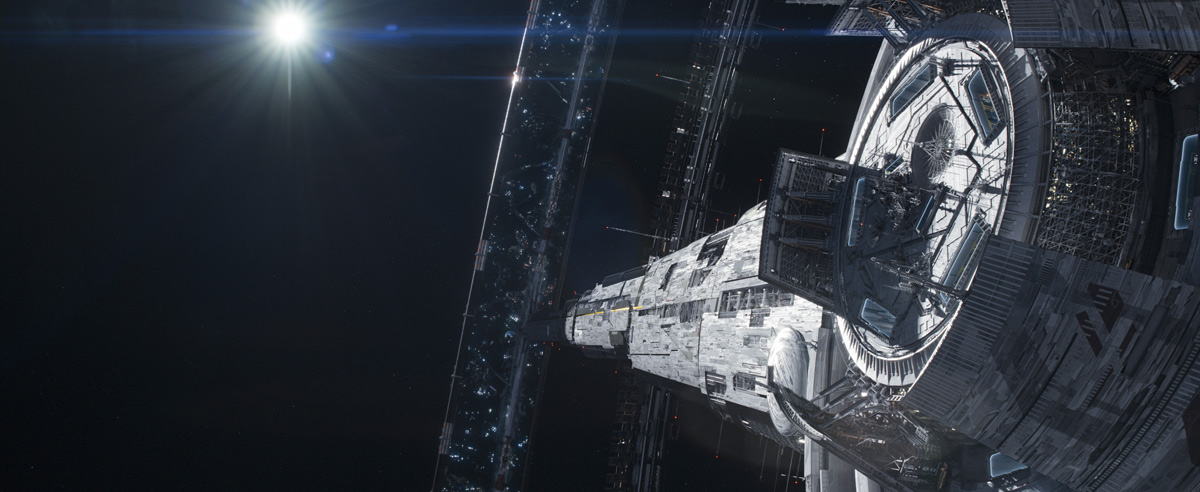Space Station Science: Could Humanity Really Build 'Elysium'?

In the new movie "Elysium," Earth is beyond repair, and the rich and powerful have decided to leave it behind.
Instead of three to six highly trained astronauts circling the Earth in an orbiting laboratory as there are today, the Elysium space station serves as an oasis for those that can afford it. In the film, humanity has developed a large, rotating space station above a dystopic Earth by the year 2154. The station comes stocked with mansions, grass, trees, water and gravity.
Although that kind of brave new world might sound far-fetched, the space station's design — and the science behind it — isn't. [See photos from the movie "Elysium"]
"The premise is totally believable to me. I spent 28 years working on NASA's International Space Station and retired last summer as the director of ISS at NASA Headquarters," Mark Uhran, former director of the International Space Station Division in NASA's Office of Human Exploration and Operations, said. "When I took a look at the Elysium space station, I thought to myself, that's certainly achievable in this millennium."
The paradise of Elysium orbits above the Earth, serving as a haven for the wealthy in the film. Those people left behind on Earth have to contend with crime, extreme poverty and poor health conditions. One man (played by actor Matt Damon) decides to leave Earth and make his way to Elysium in order to save his own life.
A familiar design
The design of Elysium itself harkens back to the ideas for space stations thought up by NASA in the 1970s.
Get the Space.com Newsletter
Breaking space news, the latest updates on rocket launches, skywatching events and more!

"Back in the '70s, people were actually discussing the idea of leaving Earth and building space stations for us to potentially live on one day," the movie's director Neill Blomkamp said in the film's production notes. "One of the top answers to that challenge was the Stanford Torus. I like the idea of taking this well-known concept and caking it with wealth, diamonds and Bel Air-style mansions — the idea, the image of putting these exorbitant, ridiculous mansions on a doughnut-shaped space station is hilarious to me, and it becomes something I want to make a movie about."
Major spaceflight advances
Actually building an Elysium-like space station would require some major advances in humanity's ability to live in space for an extended period of time and it might not be able to happen in 150 years, Uhran said.
"If you threw everything you had at it, could you reach a space station of the scale of Elysium in 150 years?" Uhran told SPACE.com. "That's a pretty tall order."
Scientists would need to develop a new kind of propulsion that could haul enough material into orbit to create a huge Elysium-like station. At the moment, chemical propulsion won't cut it. Nuclear propulsion could be a viable possibility eventually, but the idea isn't ready for prime time yet.
"In order to lift that much mass into orbit or even to go retrieve it from asteroids or mine it on the moon, you probably couldn't do it with chemical propulsion," Uhran said. "That's a lot of mass in that Elysium space station."

Creating gravity
The artificial gravity on "Elysium" is also an idea that has been discussed by NASA officials before. Uhran thinks that it's possible that a space agency will want to develop a space station with artificial gravity sometime in the future.
At the moment, NASA astronauts adapt to life in microgravity instead of engineering gravity in a space environment.
"Whether or not NASA's efforts to adapt humans to microgravity will be successful if they stay in space for years at a time [is an open question]," Uhran said. "It may, and if it's not, then at some point in the future, NASA, or whoever develops space stations 100 years from now, may have to go the way of rotating spacecraft and create artificial gravity. There are plenty of concepts for doing that."
"Elysium" launches into theaters across the United States on Friday (Aug. 9).
Follow Miriam Kramer @mirikramer and Google+. Follow us @Spacedotcom, Facebook and Google+. Original article on SPACE.com.
Join our Space Forums to keep talking space on the latest missions, night sky and more! And if you have a news tip, correction or comment, let us know at: community@space.com.

Miriam Kramer joined Space.com as a Staff Writer in December 2012. Since then, she has floated in weightlessness on a zero-gravity flight, felt the pull of 4-Gs in a trainer aircraft and watched rockets soar into space from Florida and Virginia. She also served as Space.com's lead space entertainment reporter, and enjoys all aspects of space news, astronomy and commercial spaceflight. Miriam has also presented space stories during live interviews with Fox News and other TV and radio outlets. She originally hails from Knoxville, Tennessee where she and her family would take trips to dark spots on the outskirts of town to watch meteor showers every year. She loves to travel and one day hopes to see the northern lights in person. Miriam is currently a space reporter with Axios, writing the Axios Space newsletter. You can follow Miriam on Twitter.